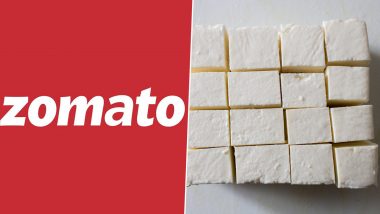Mumbai, October 23: What if the paneer you ordered at your favourite restaurant isn't the real deal? As Zomato faces backlash for supplying restaurants with "fake paneer" through its B2B service, Zomato Hyperpure, the question of food authenticity looms larger than ever. While the company labels its product as "Analogue Paneer," concerns have arisen about its use in traditional dishes like tikka and gravies. As consumers increasingly prioritise food authenticity and safety, the implications of serving analogue paneer without proper disclosure raise significant questions.
But how can diners be sure they're getting the real thing? Testing for authenticity in paneer is vital, especially as restaurants may not disclose the use of analogue products. While analogue paneer may replicate the texture and flavour of the real thing, it lacks the nutritional benefits that come from genuine dairy products. Understanding the differences between these two types of paneer is essential for making informed choices about what we consume. Protein-Rich Vegetarian Recipes: From Matar Paneer to Rajma, 5 Easy-To-Make Indian Dishes That Are Packed With Protein (Watch Videos).
What is Analogue Paneer?
Analogue paneer or fake paneer is a synthetic alternative to traditional paneer, primarily made from non-dairy ingredients such as vegetable oils, emulsifiers, and starches. It is designed to mimic the texture and flavour of genuine paneer, which is made by curdling milk with an acid. Unlike original paneer, which is rich in protein and calcium, analogue paneer lacks the nutritional benefits associated with dairy products. This imitation is often used in various dishes, particularly in restaurants, due to its lower cost and longer shelf life.
Differences Between Analogue Paneer and Original Paneer
The primary difference between analogue and original paneer lies in their ingredients and nutritional value. Original paneer is made from milk, resulting in a protein-rich product that also contains essential vitamins and minerals like calcium. In contrast, analogue paneer is crafted from non-dairy ingredients, such as vegetable oils and emulsifiers, which often leads to a lower nutritional value. Additionally, the taste and texture of analogue paneer can be less authentic compared to traditional paneer, which has a creamy and crumbly consistency. Zomato Platform Fee Hike: Ordering Food From Zomato Becomes Costlier As Company Increases Platform Fee to INR 10 Amid Festive Season.
How to Identify Fake Paneer?
(The above story first appeared on LatestLY on Oct 23, 2024 05:25 PM IST. For more news and updates on politics, world, sports, entertainment and lifestyle, log on to our website latestly.com).













 Quickly
Quickly


